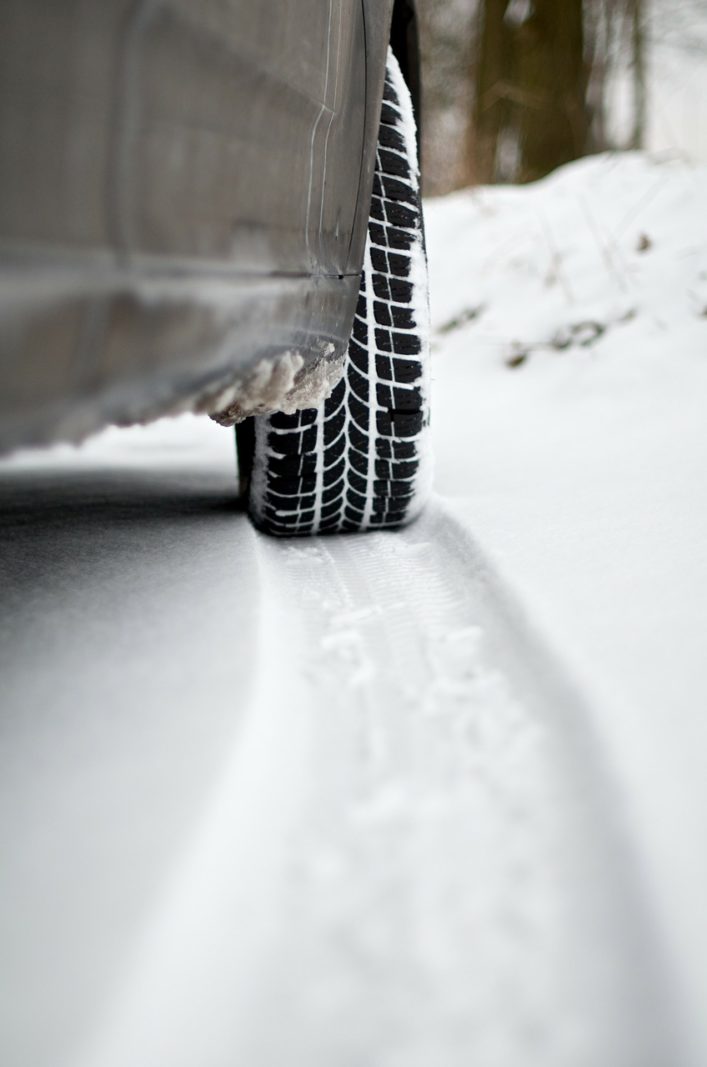There is a lot of high technology in your car tires that can be tuned from tire to tire to make them perform according to the intended vehicle type, road condition, driving style and most importantly, temperature. The main difference between winter tires and all-season tires is not something you can see. The rubber compound is by far the biggest factor in the level of winter traction you get from any given tire. The second most important difference between winter tires and all-season tires is the design molded onto the tread.
In cold weather, regular all-season tread rubber, and the rubber used in high performance summer tires, hardens at a higher temperature than the rubber compound used in snow tires. Normal all-season tire rubber hardens as temperatures drop below 42 degrees Fahrenheit. Tire rubber must be flexible to grip the road. At, or about 42 degrees Fahrenheit, an all-season and a winter tire have about the same traction, however, as the mercury drops the winter tire gains grip, while all-season tires and high performance tires, lose traction.
At temperatures well above 42 degrees Fahrenheit, the rubber in all-season tires stays hard to resist wear. In contrast, the rubber in the tread of a winter tire will soften, and wear out much faster. For this reason, winter tires should be removed from the vehicle early in the spring and replaced in late fall when the temperatures regularly dip below 42F. Even the most premium winter tires, like the Nokian Hakkapeliitta 8 or the Michelin X-Ice Xi3 are not intended to last in the heat of summer.
Another contributor to the amount of winter traction is the pattern molded into the tread. Long lasting, summer tires typically have solid ribs, separated by wide circumferential grooves. This type of tread is optimized for long tread-life, good fuel efficiency and a quiet ride on smooth roads. Regular all-season tires often have solid tread blocks arranged in a chevron-shaped pattern with wide grooves.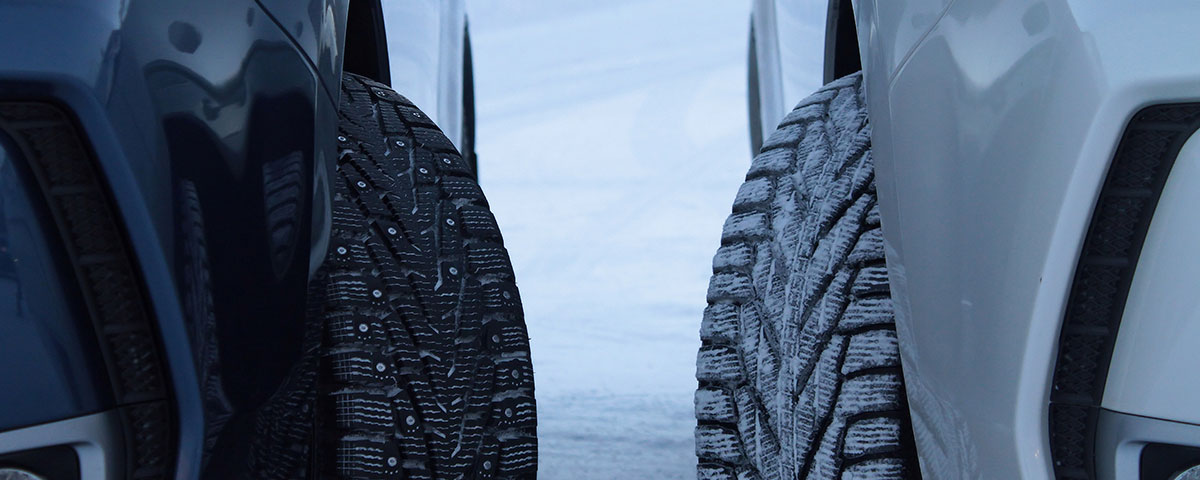 These treads are ideal for evacuating water from under the tread, but for traction on ice and snow, tires need a high density of biting edges. Tire Engineers achieve this by molding tread narrow slits into the tread features. Often the tread features are covered in this fine slits, or tread sipes. Tread sipes provide a biting edge, while maintaining the integrity of the tread for better handling and lower noise levels. Examples of winter tire styles with very high sipe density to aid in snow and ice grip are the Arctic Claw TW1, Bridgestone Blizzak WS80 and Antares Grip 20 tire.
These treads are ideal for evacuating water from under the tread, but for traction on ice and snow, tires need a high density of biting edges. Tire Engineers achieve this by molding tread narrow slits into the tread features. Often the tread features are covered in this fine slits, or tread sipes. Tread sipes provide a biting edge, while maintaining the integrity of the tread for better handling and lower noise levels. Examples of winter tire styles with very high sipe density to aid in snow and ice grip are the Arctic Claw TW1, Bridgestone Blizzak WS80 and Antares Grip 20 tire.
The name of the tire, and the markings on the side of the tire are also an indication of the intended use. A common marking on a winter tire is the Three Peak Mountain Snowflake Symbol. When this marking is on a tire you know it meets specific snow traction performance requirements set by the Rubber Manufacturer’s Association of America and the Rubber Association of Canada. All-season tires never have this marking. More typically, all-season tires will have the more generic M+S marking. M+S marked tires are not a good indicator of performance on cold winter roads, ice, or even packed snow.
More typically, all-season tires will have the more generic M+S marking. M+S marked tires are not a good indicator of performance on cold winter roads, ice, or even packed snow.
Tires-easy.com has a huge variety of winter tires for all types of cars and driving styles. Use our tire selector to find your size and tire brand and style to fit your budget.
Create an account for free on Tires-Easy.com and check out the discounted prices on a great selection of tires.
Sign Up
There are two common grading systems for tires to help identify winter tire traction capabilities. All tires that pass certain winter tire traction tests can be marked with a symbol molded onto the side of the tire. One is the M+S (mud and snow) symbol, and the second is the mountain/snowflake symbol. Both are based on standardized tire industry testing, however the extent of testing, and the traction levels required to qualify for each symbol are very different. While both symbols are helpful indictors of what you can expect from the tire, it is important to understand the difference between the two. This is particularly important when deciding on which tires to purchase for your car, SUV, CUV or light truck in colder climates.
While both symbols are helpful indictors of what you can expect from the tire, it is important to understand the difference between the two. This is particularly important when deciding on which tires to purchase for your car, SUV, CUV or light truck in colder climates.
M+S symbol usually found on the side of the tire near the wheel flange
The M+S tire marking system was first introduced to differentiate knobby bias-ply tires from the more common rib treads on early radial car and light truck tires. Over time, M+S became a standard marking to show the tire had some “all-season” capability compared to summer tires. Unfortunately, it is a very one-dimensional test in that it only measures traction in packed snow and mud. It does not measure traction on ice, slush or traction on cold dry roads. For that reason the M+S Symbol falls short in helping fully evaluate winter tire performance expectations in winter driving conditions.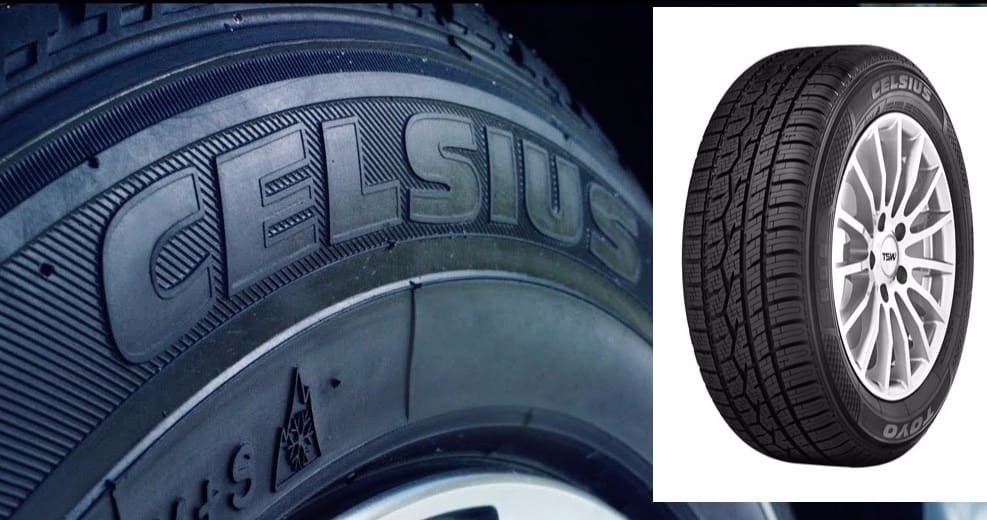
Three Peak Mountain Snowflake symbol is on many Winter Tires.
Recognizing a need for a more up-to-date and helpful measurement of true winter performance, as well as a way to differentiate all-season tires from winter tires, the Rubber Manufacturers Association (RMA) came up with the Mountain/Snowflake symbol for tires. When you see this icon on the sidewall of your tire, you can be assured it meets more stringent winter traction performance requirements and has been rated for “severe snow service”. This includes snowy, slippery roads and low temperature or freezing roads. Most all-season tires do not qualify for the Mountain/Snowflake symbol because the tread rubber in all-season and summer tires become hard at temperatures below 40 F. Only dedicated winter tires, select all-terrain light truck and SUV tires, and some of the latest generation “all-weather tires” meet the traction qualifications for the Mountain/Snowflake symbol’s severe snow service rating. One “all-weather” tire with the Mountain/Snowflake symbol is the Nokian WR G3 tire. The Nokian WR G3 are tires that you can leave on the vehicle all-year round, and still be assured of good traction in winter conditions other than just light snow. Nokian also makes a full line of winter tires for all vehicles and their new Hakkapeliitta 9 studded tire is a great choice for severe weather conditions.
One “all-weather” tire with the Mountain/Snowflake symbol is the Nokian WR G3 tire. The Nokian WR G3 are tires that you can leave on the vehicle all-year round, and still be assured of good traction in winter conditions other than just light snow. Nokian also makes a full line of winter tires for all vehicles and their new Hakkapeliitta 9 studded tire is a great choice for severe weather conditions.
At this time, there are only a few areas in North America were winter tires are mandatory. In some Canadian provinces, only tires bearing the Mountain/Snowflake symbol are considered acceptable winter/snow tires, and by law must be used from October through March. Winter tire usage laws are under consideration for some northern U.S. states as well, but for the time-being, good all-season tires that carry the M+S symbol continue to be the broader definition for the minimum acceptable levels of winter traction.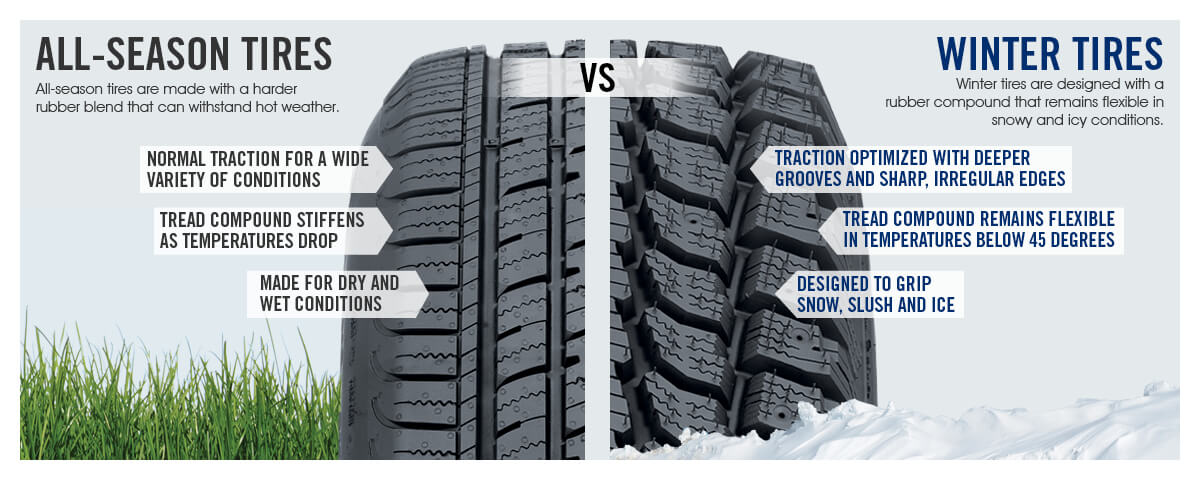 M+S rated tires or snow chains are usually permitted in mountain passes and other areas under winter weather advisory conditions.
M+S rated tires or snow chains are usually permitted in mountain passes and other areas under winter weather advisory conditions.
Regardless of the local laws and regulations, winter tires are proven to increase safety and reduce accidents if you regularly drive in snow, slush, ice, or cold conditions, or live in an area that regularly experiences winter temperatures below 45 degrees. Visit Tires-easy.com to find all your winter/snow tire needs or check out another helpful post, How to Buy Tires Online: A Complete Guide.
Join Today For Free
Advanced search
Every autumn, car owners have to drive through slush, and later through snow and ice. As always in our country, winter comes unexpectedly, despite all the attempts of weather forecasters to predict its onset. It is possible that it will snow tomorrow, and in a week the roads will become icy - such is our country with its unstable climate. That is why it is better to take care of comfort and safety in advance and choose all-season or winter tires. This is where the question arises - which is better? So, let's figure out which is which.
All season tires are a cross between winter and summer tires. They are ideal for countries with mild climates in both summer and winter. For Russia, they are not so well suited, but lately the winters are getting warmer and all-season tires are more and more in demand. You can distinguish all-season tires from the rest by the following features:
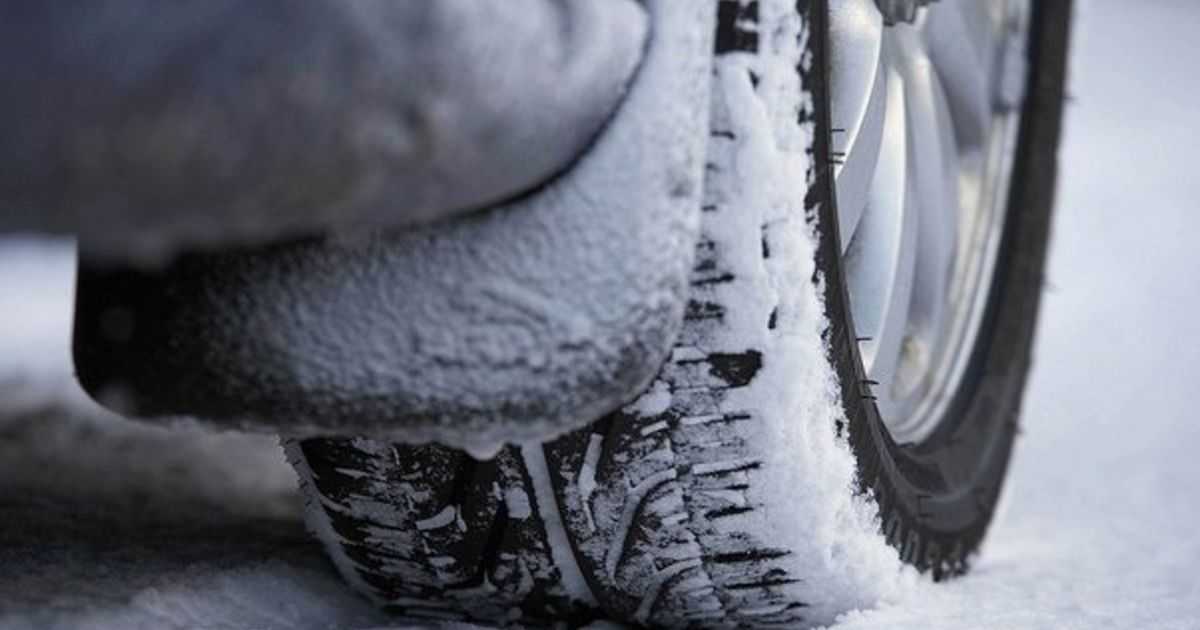
Winter tires, on the other hand, are ideal for severe frosts, deep snow and icy road surfaces. The pattern of their treads is strongly pronounced, which allows you to literally dig the snow under you. Winter tires come with or without studs. Studded tires bite into the ice and allow you to move more confidently and safely in winter. In addition, winter tires are made from a special composition, which allows them to warm up while driving and become very soft and elastic. Thanks to this unique quality, the flotation of winter tires is so high. The price of winter tires is slightly higher than all-season tires, but they are safer and more reliable in winter. The distinguishing features of winter tires are as follows:
Here we come to the main question.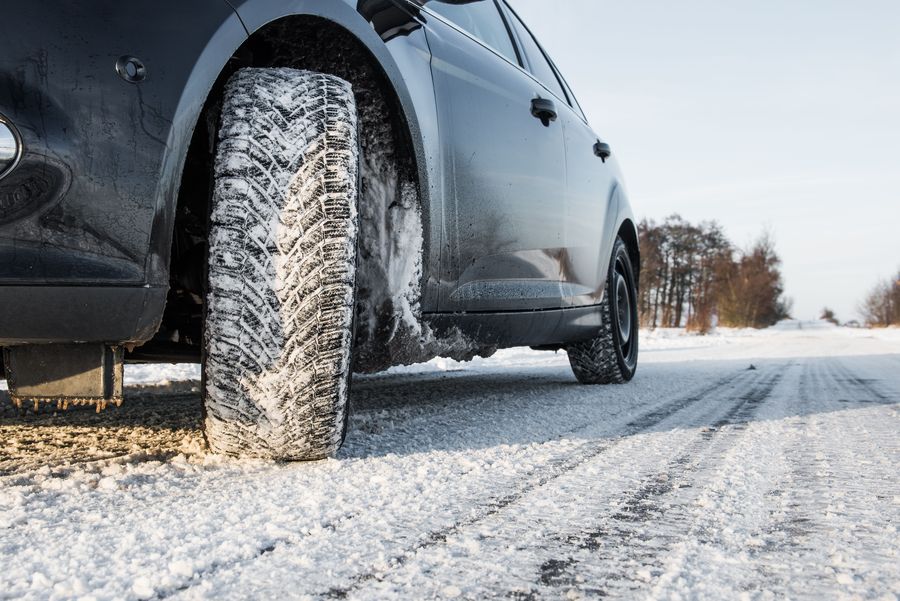 What to choose, which tires are better - those that are cheaper or those that are more reliable? In fact, both tires have their undeniable advantages and disadvantages. Everyone must decide for himself what is more important for him - cost or quality. In addition, remember that you don’t ride winter tires in the summer (their quality will suffer greatly from this), but all-weather tires are great for this.
What to choose, which tires are better - those that are cheaper or those that are more reliable? In fact, both tires have their undeniable advantages and disadvantages. Everyone must decide for himself what is more important for him - cost or quality. In addition, remember that you don’t ride winter tires in the summer (their quality will suffer greatly from this), but all-weather tires are great for this.
Also, winter tires are distinguished by the so-called noisiness, while all-season tires are quieter and do not cut the ear. All-season tires won't work for you if you own a sports car and want to drive it in the winter - these tires are not only not suited for fast speeds, but they are not as good in the cold season, but rather even bad. Therefore, the choice is yours, think and weigh all the pros and cons before deciding which tires to buy.
Rubber provides grip and transfers engine power to the asphalt. It is important to choose the right kit for your car so that the operation of the car is as efficient as possible. Each set has such a parameter as tire seasonality. Next, information will be provided on all-season tires, the features of their marking and the properties of this rubber.
Each set has such a parameter as tire seasonality. Next, information will be provided on all-season tires, the features of their marking and the properties of this rubber.
In order to identify all-season tires by marking, such tires have an additional designation in the form of the letters M + S. The abbreviation Mud+Snow means that the kit provides reliable traction in difficult weather conditions. In addition, all-season tires are indicated by the symbols 4S, AS or AW (4 Season, All Season or All Weather).
However, it should be understood that, in fact, all-season tires lose to winter tires at low temperatures and lag behind summer tires at serious air temperatures. In fact, these tires are considered rather off-season.
Contents:
Various sets of seasonal tires are offered for the car, which differ in their characteristics and composition. Tires for the winter are made of soft grades of rubber, which will allow the tire not to tan. In addition, such products have a developed tread pattern and a high profile, which allows you to cling to snow porridge and effectively drain water.
Tires for the winter are made of soft grades of rubber, which will allow the tire not to tan. In addition, such products have a developed tread pattern and a high profile, which allows you to cling to snow porridge and effectively drain water.
The difference between summer tires in hard rubber. This tire perfectly tolerates high loads and does not melt while driving, confidently clinging to the surface. The profile height is small, and the contact patch with the road is the most extensive. However, in low-temperature conditions, it hardens and does not provide proper grip, which results in a long braking distance.
Each set has a concept of tire seasonality. Despite the fact that tires of a certain composition are labeled as all-season tires, such a set is demi-season tires. These all-season tires have a softer rubber compound. In summer, the all-season will overheat and “float”, which will lead to premature wear.
In summer, the all-season will overheat and “float”, which will lead to premature wear.
In case of extremely low temperatures, tires will lose to their winter counterparts. Such kits work most effectively at near-zero levels, providing proper grip on cold asphalt, slush or rain. In such conditions, rubber can be used, but it is not worth riding it all year round; it is worth putting profile shoes for the winter or summer season.
Each set has its pros and cons. All season tires are no exception.
Benefits:
Disadvantages:
It is mandatory to have regulated inscriptions on the side surface of the tire. The logo and the name of the rubber manufacturers, as well as the name of the brand, are printed in large letters. Some car manufacturers may recommend certain brands as the most suitable for the model. This is what Chevrolet or VAZ do.
The logo and the name of the rubber manufacturers, as well as the name of the brand, are printed in large letters. Some car manufacturers may recommend certain brands as the most suitable for the model. This is what Chevrolet or VAZ do.
The tire size is also marked on the sidewall of the tire. There is a European type of marking. For example, readings 205 * 35 * R17 make it clear that the width of the tire is 205 mm, the profile height is 45, and the inner diameter is 17 inches. The letter r means that we have a shoe with a radial cord weave.
The American method is similar to the European one, only there are additional letters in front of the numbers, which signal the "orientation" of the rubber (P - Passanger, LT - Light Track). There is another way in which the standard size is indicated, where the values \u200b\u200bare given in inches. For example, if there is a number 29 * 11 * R18 on the side, its decoding will mean the following:
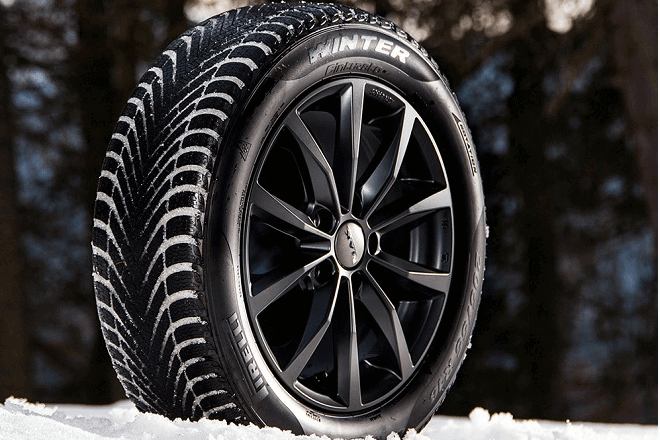
Another mandatory parameter is the speed index. This is a letter designation that indicates that the car can move at a given speed for several hours. The closer the letter is to the end of the Latin alphabet, the higher this indicator. Now the most common are kits with indices S, T, U, H V or W, allowing you to reach speeds of 180-190-200-210-240 or 260 km / h, respectively.
Together with the speed category, tire manufacturers put down two more numbers - the maximum load index. This parameter means that the tire is capable of driving under the specified weight on one wheel, subject to maximum pressure. The indicator is indicated in kilopascals closer to the inner radius.
The higher the value, the greater the load that the wheel can carry. The minimum value in the industry is 1 - 46.2 kg per wheel, and the maximum figure is 279 - 13.6 tons per cylinder.
Sometimes the marking of all-season tires can be supplemented with various badges. Among the additional designations you can find the inscription "Retread". The fact is that some sets are subject to repair and the mixture is re-fused on them and the tread is cut. Remanufactured products bear this designation. Riding on such rubber does not threaten anything, however, the tire bought by the driver will wear out a little earlier. Fortunately, the price is cheaper.
Among the additional designations you can find the inscription "Retread". The fact is that some sets are subject to repair and the mixture is re-fused on them and the tread is cut. Remanufactured products bear this designation. Riding on such rubber does not threaten anything, however, the tire bought by the driver will wear out a little earlier. Fortunately, the price is cheaper.
Some car tires and rims do not fit together, with fundamental differences in design. So, if you are going to change the tires of a car with your own hands, it is worth remembering that chamber kits must be installed on the corresponding wheels with the designations LK, GK or RK. The symbols LB, GB or RB indicate a combination with tubeless type kits (TubeLess).
Tire installation regulations govern the presence of colored markings. If there is a yellow triangle icon on the sidewall, then this is the lightest part of the rubber. All that needs to be done is to align it with the label on the disk. The red dot indicates the hardest point and should also be aligned with the L mark on light alloy wheels.
The red dot indicates the hardest point and should also be aligned with the L mark on light alloy wheels.
Be sure to mark the tire with four digits indicating the date of manufacture of the kit. In the first two, the ordinal number of the week is encrypted, and the last - an indicator of the year in which the wheels were made. The number 2517 indicates that the rubber was produced in the 25th week of 2017.
We told you how to distinguish winter tires from summer tires - by the snowflake icon. However, for choosing shoes for a non-trivial car, this knowledge may not be enough. When purchasing wheels for a crossover, you should imagine where the car will spend most of the time. If in the city, then standard tires with the designation AW (All Weather or Aqua - improved drainage and increased resistance to aquaplaning) are a good fit.
If the car goes beyond the definition of an SUV and you plan to go out into nature, then it is better to give preference to sets with a developed tire tread, improved lugs and increased cross-country ability.